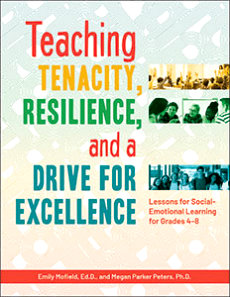Lessons in Tenacity and Resilience (Grades 4-8)
Teaching Tenacity, Resilience, and a Drive for Excellence: Lessons for Social Emotional Learning for Grades 4 – 8
By Emily Mofield and Megan Parker Peters
(Prufrock Press, 2018 – Learn more)

When I first encountered Teaching Tenacity, Resilience, and a Drive for Excellence, several students from my current and past classes came to mind: a bright student who shows little motivation for academic learning; a student who encounters obstacles like a missing notebook and gives up; a student whose self-deprecating and sarcastic comments about his intelligence belie a fear of failure. Sound familiar?

24 lessons to instill 3 principles
Twenty-four lessons – from “Adopting a Growth Mindset” to “Handling Mistakes” to “Hope and Learned Optimism” – help instill in students a sense of self-worth and give them the tools to gain greater self-awareness.
The lessons orient around three guiding principles. The authors define Mindful excellence as the impact thoughts and emotions have on one’s drive to improve and excel. Leaning-in and pushing through the discomfort produced by a new idea or stressful situation can provide a means for growth. And finally, through reframing thinking students can adapt their mindset to see obstacles as opportunities.
Both authors have significant background in working with gifted students and continue to be active in the area of educating gifted children. A bonus twenty-fifth lesson available on-line helps students understand giftedness. Their introduction describes how the book may also be applicable to underperforming students (primarily those who are unmotivated) and kids from disadvantaged populations.
Adapting lessons for students with IEPs
With this in mind, I wondered how the lessons would meet the needs of my students with IEPs. Some of the lessons need additional differentiation; for example, an activity that includes a multi-faceted math game may provide “discomfort” for some, but would cause others to shut down. However, other lessons, such as “Understanding Emotions” and “Managing Emotions,” are essential for students who find intrapersonal tasks a challenge — perhaps more important for others than for my gifted students, some of whom have a well-developed emotional intelligence.
Incorporating lessons into daily advisory and content areas
My second question was how the lessons would fit into our 25-minute daily advisory program, and in particular, how they would fit within the framework of the existing program we use.
Mofield and Peters have structured their lessons around several components, including an introduction or hook, class activity, connections, curricular extensions, reflection and assessment. While these lessons could easily fill a 45-minute period, with a little adjustment each could be split to span a shorter period. For example, the “conclusion connection” could serve as a hook for the second day’s lesson using the extension or reflection as the day’s activity. It looks like I may have the next twelve weeks of my advisory period planned!
Advisory isn’t a must
Don’t shy away from Teaching Tenacity if your school doesn’t offer an advisory program. The curricular extension section puts each lesson into the context of a content area.
For example, in “Managing Emotion,” students research how emotion is processed in the brain, tying into a life-science class. In “Understanding Emotions,” students view and respond to a piece of art and discuss or write about their emotional response. In “Face-to-Face With Obstacles,” students explore the obstacles faced by a character in a novel and write a response giving advice to the character about how to meet or overcome the obstacles.
A cross-curricular team of teachers could tackle the lessons together, incorporating them over the course of a year through the curricular extensions.
Swimming against the tide? An ELA teacher could incorporate the lessons over the course of a year and offer students a deeper experience of both the literature they encounter and their own lives. Your colleagues might even start asking for your secret!
One resource suggestion
While for the most part the lessons can be used as they are, in several places the authors reference material “on-line.” In some cases, the prompt is specific, such as finding a copy of Rudyard Kipling’s poem “If.” In other cases, the prompts are more vague: “Have students read a summary or online article of Brooks’s research on reframing anxiety as excitement… (various articles are available on line).” I certainly appreciate that published web sources in a book can quickly become out-of-date. However, an online collection of resources would make an excellent companion to this text and could be checked for freshness periodically.
I, for one, am willing to do a few internet searches to implement this curriculum. I look forward to watching my students transform as they develop tenacity, resilience, and a drive for excellence.
Jeny Randall teaches 6th grade Language Arts and science at Saratoga Independent School in New York State. As Middle School Coordinator, she is overseeing the curriculum and program development for the new middle school. Outside of school Jeny teaches yoga, reads whatever students send her way, and spends time with her family – outside if possible.






























